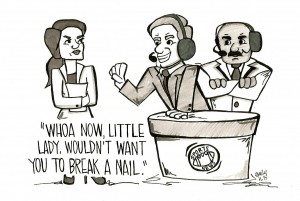 The Institute for Diversity and Ethics in Sport published a report on gender and race makeup in 150 newspapers and websites in 2012. The report found that 90.4 percent of sports editors were males and 88.3 percent of sports reporters were men. Of the 11 women that were sports editors, six of them worked for ESPN.
The Institute for Diversity and Ethics in Sport published a report on gender and race makeup in 150 newspapers and websites in 2012. The report found that 90.4 percent of sports editors were males and 88.3 percent of sports reporters were men. Of the 11 women that were sports editors, six of them worked for ESPN.
The problem with this situation is that women such as Melissa Ludtke, one of the first women to become a mainstay in professional sports locker rooms after she successfully sued the MLB in 1978 for access, and Claire Smith, who is the first individual to win the Sam Lacy-Wendell Smith Award, which goes to a journalist who made major contributions to racial and gender equality in sports, battled for years only to still see gender inequality in the sports media industry in 2015.
Women are typically designated the role of sideline reporter. If lucky, one woman gets to sit at a table with multiple men to talk sports on networks such as ESPN or NBC Sports. The mentality is to be seen and not heard.
The notion is that these women are to be revered or disliked based on their appearance, rather than the quality of their work. Even the women that are not publicly seen – the women involved in the writing aspect – are not taken as seriously as their male counterparts.
When a female makes a mistake in her writing or broadcasting she is attacked as if she doesn’t know anything about the sport, while society will typically view a male’s error as a legitimate mistake.
For example take Jennifer Gish, a journalist who wrote a column in 2011 for the Albany Times-Union. Gish wrote a humorous and satirical, yet lighthearted column about the Buffalo Bills, a regularly awful team that was having a rare good start to the season. Gish jokingly warned fans to not get too excited about the first few games, as the typical Buffalo Bills do not end with a winning season. The newspaper, in response to Gish’s article, received over 800 angry calls and emails, many of which arguing for more press coverage of the team, and by a male reporter, according to The Washington Post. Comments included, “You may want to consider plastic surgery or something, you are one God-awful looking female,” and, “I am hoping you went to some sort of formal schooling to get the position you have or you have worked your way up from doing a lot of under-the-desk work.”
The New York Times released an article Jan. 6 informing readers their usual Knicks beat reporter, Scott Cacciola, will be taking a break from covering the team, as their record at the time was 5-32. The article called for readers to add comments, suggesting a new topic for Cacciola to cover as Cacciola wanted to be saved from a team that appeared to have “officially given up on the season.” Of the 345 comments, very few, if none, demanded Cacciola continue to cover the team despite its hardships or asked for a different reporter to continue to cover the Knicks.
Of course there are talented women that are highly successful in sports journalism. But are there enough? No. An argument exists that not enough women pursue a career in sports journalism and that is the reason they are quite rare in the business. But the reason these women are seen as rare is because society does not support their endeavors.
Society does not support female play-by-play announcers, female sports radio talk shows or female television hosts and because of the lack of societal support, a television network will not put itself in the position to receive viewers’ ire. Gayle Sierens in 1987 became the first woman to do play-by-play for the NFL during a regular season game and has been the only woman to do so since. After much thought and consideration, a very small and limited number of current female play-by-play announcers have come to mind, and that list is limited to Doris Burke who announces NBA basketball, Suzyn Waldman who calls New York Yankees games on the radio and Beth Mowins who does college football for ESPN.
Fortunately, all hope is not lost. Current opportunities in sports journalism for women are statistically on the rise. Are they legitimate opportunities that male counterparts would consider honorable and accredited, or are they eye-candy jobs on the sidelines? It will probably be a mix of both, but until women are taken as seriously as men in sports journalism I would at least appreciate it if ESPN or NBC Sports could find me the male equivalent of Erin Andrews.
Caporaso, a sophomore journalism major from Port Jefferson Station, New York, is a senior news reporter.
